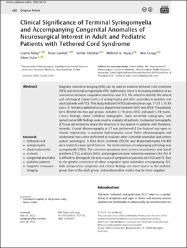| dc.contributor.author | Rakip, Usame | |
| dc.contributor.author | Canbek, İhsan | |
| dc.contributor.author | Yıldızhan, Serhat | |
| dc.contributor.author | Boyacı, Mehmet Gazi | |
| dc.contributor.author | Cengiz, Akın | |
| dc.contributor.author | Aslan, Adem | |
| dc.date.accessioned | 2024-03-19T08:01:44Z | |
| dc.date.available | 2024-03-19T08:01:44Z | |
| dc.date.issued | 2022 | en_US |
| dc.identifier.citation | Rakip, U., Canbek, İ., Yıldızhan, S., Boyacı, M. G., Cengiz, A., & Aslan, A. (2022). Clinical Significance of Terminal Syringomyelia and Accompanying Congenital Anomalies of Neurosurgical Interest in Adult and Pediatric Patients with Tethered Cord Syndrome. Journal of Child Science, 12(01), e92-e103. | en_US |
| dc.identifier.uri | DOI https://doi.org/ 10.1055/s-0042-1757142. | |
| dc.identifier.uri | https://hdl.handle.net/20.500.12933/1848 | |
| dc.description.abstract | Magnetic resonance imaging (MRI) can be used to examine tethered cord syndrome
(TCS) and terminal syringomyelia (TS). Additionally, there is increasing evidence of an
association between congenital anomalies and TCS. We aimed to identify the clinical
and radiological characteristics of syringomyelia and other anomalies in pediatric and
adult patients with TCS. This study included 54 TCS patients (mean age, 17.37 15.83
years; 31 females) admitted to our department between 2010 and 2019. The patients
were divided into two age groups: pediatric (<18 years; 63%) and adult (>18 years).
Clinical findings, direct vertebrae radiographs, lower extremity radiographs, and
spinal/cranial MRI findings were used to evaluate all patients. Computed tomography
(CT) was performed to reveal the structure of the septum in patients with Diastematomyelia. Cranial ultrasonography or CT was performed if the fontanel was open or
closed, respectively, in pediatric hydrocephalus cases. Pelvic ultrasonography and
urodynamic tests were performed to evaluate other comorbid anomalies and urinary
system pathologies. A thick filum terminale (73.3%) and diastematomyelia (44.4%)
were found to cause spinal tension. The most common accompanying pathology was
syringomyelia (78%). The common symptoms were urinary incontinence and bowel
problems (71%), scoliosis (68%), and progressive lower extremity weakness (64.4%). It
is difficult to distinguish the exact cause of symptoms in patients with TCS and TS. Due
to the greater occurrence of other congenital spinal anomalies accompanying TCS,
both preoperative symptoms and clinical findings are more severe in the pediatric
group than in the adult group, and postoperative results may be more negative. | en_US |
| dc.language.iso | eng | en_US |
| dc.relation.isversionof | 10.1055/s-0042-1757142. | en_US |
| dc.rights | info:eu-repo/semantics/embargoedAccess | en_US |
| dc.title | Clinical Significance of Terminal Syringomyelia and Accompanying Congenital Anomalies of Neurosurgical Interest in Adult and Pediatric Patients with Tethered Cord Syndrome | en_US |
| dc.type | article | en_US |
| dc.authorid | 0000-0001-7494-0335 | en_US |
| dc.department | AFSÜ | en_US |
| dc.contributor.institutionauthor | Rakip, Usame | |
| dc.contributor.institutionauthor | Canbek, İhsan | |
| dc.contributor.institutionauthor | Yıldızhan, Serhat | |
| dc.contributor.institutionauthor | Boyacı, Mehmet Gazi | |
| dc.contributor.institutionauthor | Cengiz, Akın | |
| dc.contributor.institutionauthor | Aslan, Adem | |
| dc.identifier.volume | 12 | en_US |
| dc.identifier.issue | 1 | en_US |
| dc.identifier.startpage | E92 | en_US |
| dc.identifier.endpage | E103 | en_US |
| dc.relation.journal | Journal of Child Science | en_US |
| dc.relation.publicationcategory | Makale - Uluslararası Hakemli Dergi - Kurum Öğretim Elemanı | en_US |
















